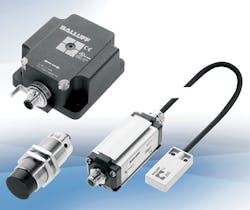Plug-and-play RFID
The IO-Link protocol allows users to connect a complex device such as an
RFID processor to an industrial network via a gateway using standard
discrete sensor wiring, making it a simple plug-and-play operation. The
IO-Link block treats the RFID data like standard I/O points. Users can
reduce costs by running multiple RFID readers off one I/O block using
standard, 3-conductor sensor cables. Compared to RS232 barcode
applications that require costly shielded RS232 cables and RS232
communication modules for the PLC, the IO-Link solution uses
cost-equivalent IO-Link-based RFID heads and processors, but offers 100%
data reliability that the barcode readers do not, says the vendor. In
addition, the IO-Link-based solution can replace the I/O enclosure, four
shielded cordsets, and a 4-port RS232 PLC module with a single IO-Link
Expansion Module and four 3-conductor, non-shielded cordsets.Balluff Inc.www.balluff.com800.543.8390

